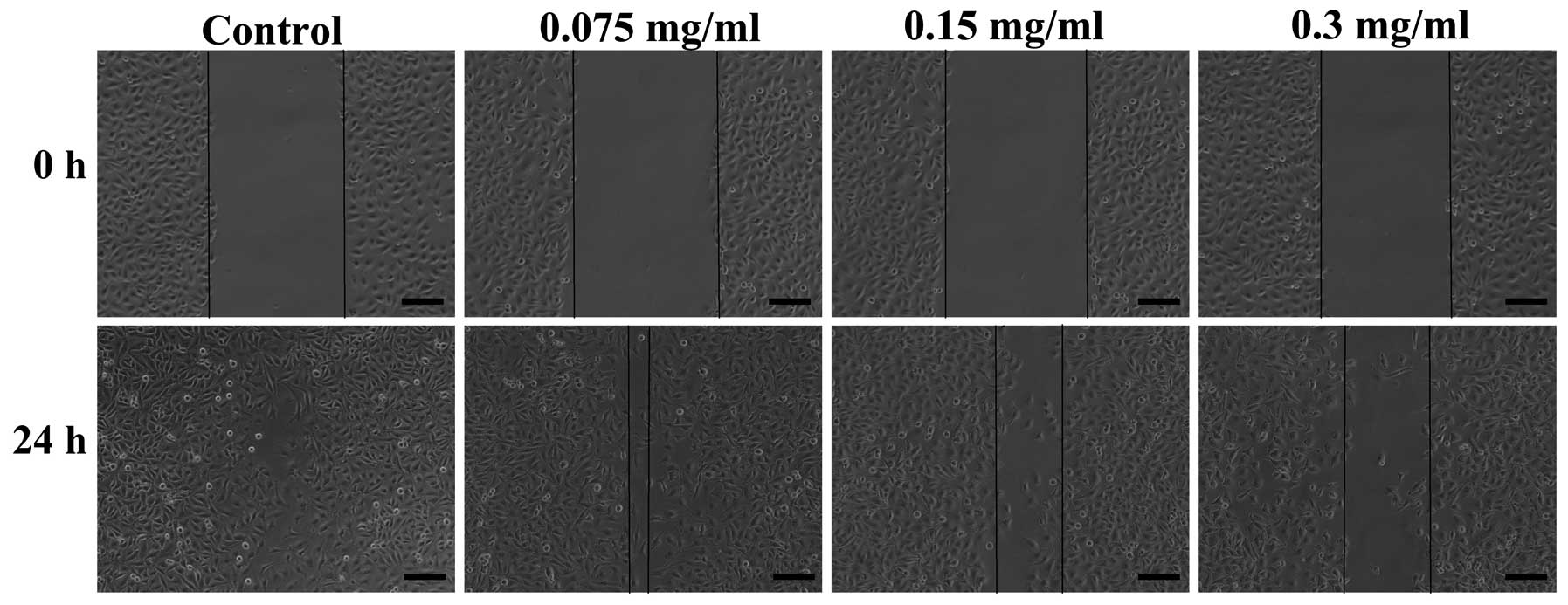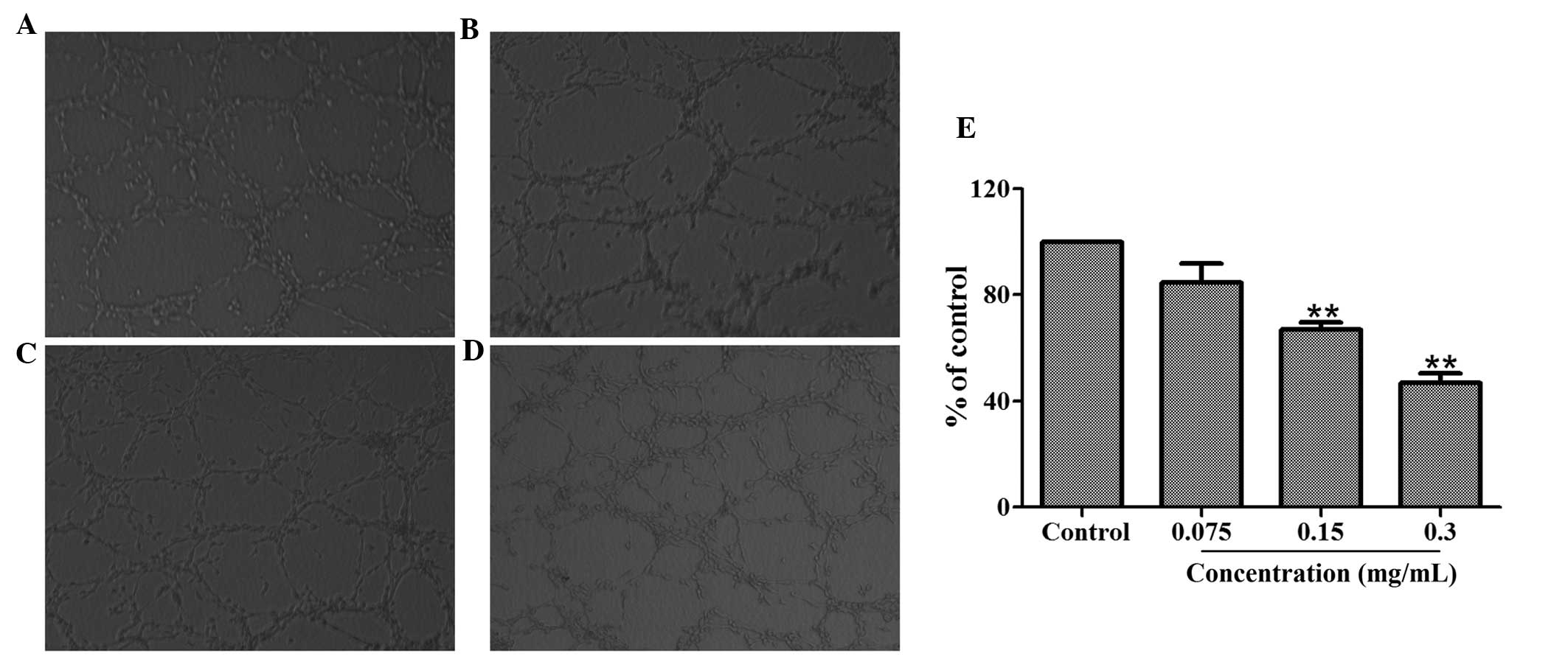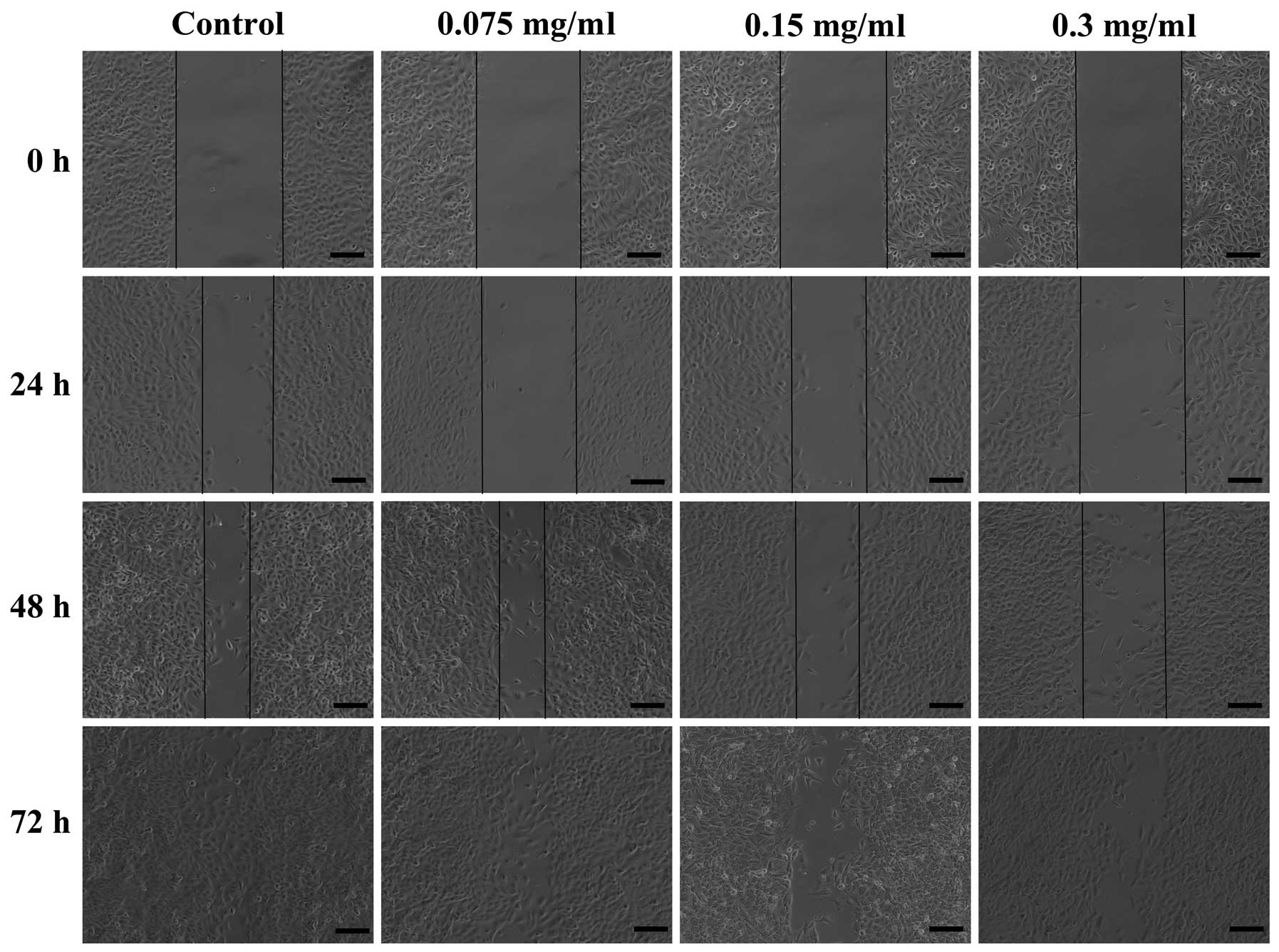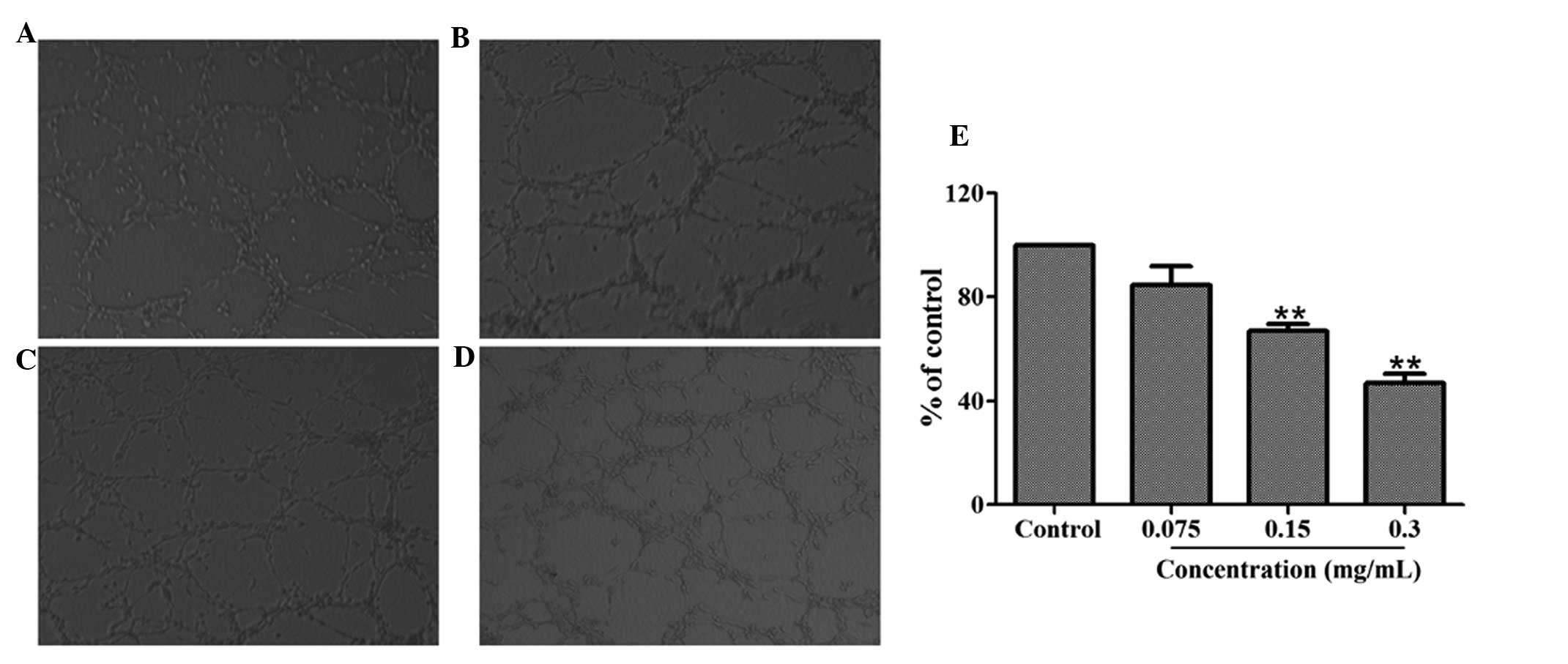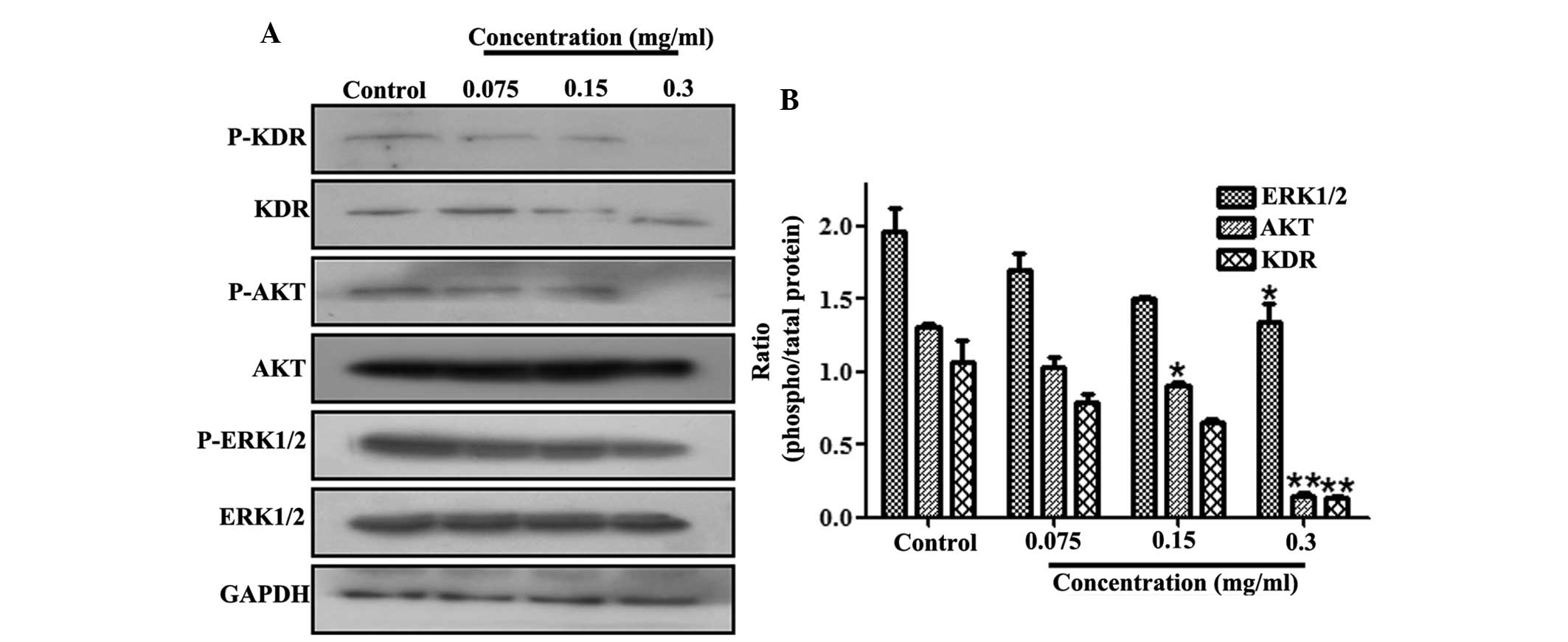Eupolyphaga sinensis Walker demonstrates angiogenic activity and inhibits A549 cell growth by targeting the KDR signaling pathway
- Authors:
- Published online on: July 16, 2014 https://doi.org/10.3892/mmr.2014.2387
- Pages: 1590-1596
Abstract
Introduction
In the early 1970s, Folkman first proposed that tumors depend on the generation of new blood vessels, a process known as angiogenesis (1). When a tumor grows beyond 1–2 mm in size, it requires new blood vessels to supply its nutritional requirements (2). Angiogenesis is a prerequisite for the growth and metastasis of solid tumors (3,4). It is regulated by a number of proteins, including vascular endothelial growth factor (VEGF), acidic and basic fibroblast growth factors, angiogenin, epidermal growth factor, scatter factor and placental growth factor (5). Among them, VEGF has been confirmed as highly important in angiogenesis in a number of preclinical and clinical studies (6,7). VEGF binds to its receptors VEGFR-1 and KDR, inducing the activation of KDR, and then regulating endothelial cell proliferation, migration and differentiation to induce the growth of new blood vessels (8). There are numerous signaling cascades involved in the VEGF/VEGFR pathway, among them phosphatidylinositol 3-kinase (PI3K)/AKT and extracellular signal-regulated kinase-mitogen-activated protein kinases (ERK-MAPK) are highly important in the regulation of cellular proliferation, migration and angiogenesis (9). VEGF is expressed in the majority of tumor types, often at a significantly increased levels (10). The expression of VEGF has been linked to tumor growth, angiogenesis and metastasis and its overexpression has been associated with a poor prognosis in non-small cell lung cancer (NSCLC) (11).
Previously, a number of anti-angiogenic drugs have been licensed or investigated in various clinical trials (12). All currently approved anti-angiogenic agents consist of monoclonal antibodies (mAbs) targeting specific proangiogenic factors (13) and synthetic tyrosine kinase inhibitors targeting multiple proangiogenic factors (14). These anti-angiogenic agents, used in combination with conventional chemotherapeutic regimens, were shown to prolong patient survival (15). Therefore, it is important to investigate antitumor activity on the basis of inhibiting tumor angiogenesis (16).
Eupolyphaga sinensis Walker is one of the numerous insects that are commonly used in Chinese traditional medicines and as a source of food (17). In long term practice, Eupolyphaga sinensis Walker has been used to treat numerous different diseases, including ecchymoma, posttraumatic wound healing, hepatic fibrosis and cancer (18). However, the antitumor effect of Eupolyphaga sinensis Walker remains to be elucidated. In the present study, its effect on A549 human NSCLC cells and the potential antiangiogenic mechanisms were examined.
Materials and methods
Reagents
RPMI-1640 and F-12K were purchased from Gibco-BRL (Carlsbad, CA, USA). Trypsin was obtained from Amresco (Solon, OH, USA). Fibrinogen from bovine plasma was purchased from Sigma (St. Louis, MO, USA) and thrombin was obtained from Guoao Pharmaceutical (Changchun, China). Anti-phospho-KDR rabbit mAb was from Upstate Biotechnology (Lake Placid, NY, USA);-AKT was obtained from Epitomics, Inc., (Burlingame, CA, USA);-phospho-AKT rabbit mAb, -p44/42 MAPK (ERK1/2) and -phospho-p44/42 MAPK (ERK1/2) rabbit mAb were from Cell Signaling Technology, Inc.(Danvers, MA, USA). Rabbit anti-GAPDH was purchased from Pierce Biotechnology, Inc. (Rockford, IL, USA). KDR and fluorescein isothiocyanate-goat anti-rabbit IgG (H+L) was purchased from Protein Tech Group Inc. (Chicago, IL, USA). Histostain TM-Plus kits and a DAB kit were purchased from ZSGB-BIO (Beijing, China). Rabbit anti-mouse IgG, goat anti-rabbit IgG, a bicinchoninic acid (BCA) protein assay reagent kit and an enhanced chemiluminescent (ECL) plus reagent kit were obtained from Pierce Biotechnology, Inc.
Preparation of Eupolyphaga sinensis Walker ethanol and water extracts
The raw material used in the study was commercially available as dry matter, which was purchased from Yishengtang Pharmacy (Xi’an, China). The 70% ethanol extract was obtained as previously described (19). The stock solution was further diluted with RPMI-1640 medium immediately prior to use. The water solution extraction from the raw powder was obtained in the same way.
Another extraction method used was as follows: The raw material was crushed and soaked in 95% ethanol overnight and then refluxed gently in ten volumes of 95% ethanol (v/w) for 1 h, and then extracted three times. Following cooling, the extracting solutions were merged and filtered to obtain a yellow oily liquid. The solvent was then evaporated under reduced pressure and concentrated to 1 g/ml (equivalent to raw material). The suspension was then centrifuged (600 g, 20 min) and filtered using a 0.22-μm microporous membrane (Shanghai Xinya Purifier Devices Factory, Shanghai, China). The stock solution was stored at 4°C and further diluted with serum-free IMDM immediately prior to use.
Cell culture
The A549 human NSCLC cell line was purchased from the Shanghai Institute of Cell Biology in the Chinese Academy of Sciences (Shanghai, China). The A549 cells were cultured in RPMI-1640 medium supplemented with 10% fetal bovine serum (FBS) and incubated at 37°C in a 5% CO2 atmosphere. Human umbilical vein endothelial cells (HUVECs) from the American Type Culture Collection (Manassas, VA, USA) was cultured in F-12K media supplemented with 0.1 mg/ml heparin, 0.5 mg/ml endothelial cell growth supplement and 10% FBS. The cells were incubated at 37°C in a 5% CO2 atmosphere.
Mice
Kunming SPF mice (age, 4–6 weeks; weight, 18–22 g) were provided by the Animal Research Center of Xi’an Jiao Tong University (Xi’an, China). The mice were maintained under laminar air flow conditions with a 12 h light (6:00-18:00)/12 h dark (18:00-6:00) cycle. Laboratory food and water were freely available. The animal care procedures were in accordance with the National Institute of Health guidelines and the Animal Research Committee of Xi’an Jiao Tong University (Xi’an, China).
Cell viability assay
The cell viability was assessed by the tetrazolium-based assay (MTT assay). Exponentially growing A549 cells were plated onto the 96-well plate (in RPMI-1640 with 10% FBS) and cultivated for 24 h. A series of different concentrations of 70% ethanol extract, water extract and 95% ethanol extract in serum-free RPMI-1640 medium were then added to the 96-well plate for 48 h. Following 48 h, 180 μl serum-free medium and 20 μl MTT solution (5 mg/ml) were added to each well. The plates were incubated at 37°C for 4 h. The supernatants were then removed and the formazan crystals were dissolved with 150 μl dimethyl sulfoxide and shaken thoroughly for 15 min on an orbital shaker (TS-100; Kylin-Bell Lab Instruments Co., Ltd., Jiangsu, China) prior to measurement. HUVECs were treated with 70% ethanol extract for 48 h followed with the above experimental method. The absorbance was measured at 490 nm in a microplate reader (Bio-Rad Laboratories, Hercules, CA, USA). The results are expressed as a percentage of the cell inhibition ratio. Percentage of proliferation ratio = (ODtreatment group-ODblank group)/(ODcontrol group-ODblank group) × 100%. The experiments were performed in triplicate.
Wound healing assay
HUVEC and A549 cells were seeded onto the 12-well plate (6×105 cells/ml) and cultivated to ~80% confluence overnight. The wounds were made the following day by scratching the cells with pipette tips (100–200 μl). The HUVEC and A549 cells were then treated with 70% ethanol extract at various concentrations (0, 0.075, 0.15, 0.3 mg/ml) for different times to allow the cells to migrate into the scratched area. The migration of cells was visualized at time 0 (right after the wound was scratched) and 24, 48 and 72 h following 70% ethanol extract treatments.
Tube formation assay
A 48-well plate was coated with 200 μl/well lypolymerized fibrinogen (diluted in serum-free RPMI-1640 to 3 mg/ml) and 5 μl/well thrombin (50 U/ml), and incubated at 37°C for 30 min to form a gel layer. Following gel formation, 1×105 HUVECs were seeded into each well in 500 μl of 10% FBS-containing RPMI-1640 medium and various concentrations of 70% ethanol extract (0, 0.075, 0.15 and 0.3 mg/ml) were applied to each well for 24 h. The images of the formation of capillary tubes were then captured randomly under a microscope (DM505; Nikon Co., Ltd., Otawara, Japan). The length of the tubes was measured with using Image-Pro Plus software (Image-Pro Plus 5.1; Media Cybernetics, Inc., Rockville, MD, USA), with three images from separate experiments for each data point. The inhibition rate of tube formation was calculated as: [1-(tube lengthtreated/tube lengthcontrol)]×100.
Inhibition of angiogenesis in lung tissue
The mice (weight, 15–18 g) were soaked in 75% alcohol for 5 min after they had been sacrificed by cervical dislocation. Subsequently, lung tissue was cultured as previously described (20). The second layer of fibrin matrices with thrombin were placed on the lung tissue to form a sandwich structure. Following consolidation, 200 μl/well RPMI-1640 medium containing different concentrations of 70% ethanol extract (0, 0.075, 0.15 and 0.3 mg/ml) was added to the 48-well plate. The 48-well plate was incubated at 37°C in a 5% CO2 atmosphere. The sprouting vessels were observed at the 5th day post treatment, the total number of microvessels were counted under a microscope and the mean values ± standard error of the mean were calculated. These experiments were conducted on three separate mice and repeated three times.
Western blot analysis
The A549 cells treated with 70% ethanol extract (0, 0.075, 0.15, 0.3 mg/ml) for 48 h were extracted with radioimmunoprecipitation assay buffer on ice for 30 min. The insoluble protein lysate was removed by centrifugation at 9,300 g for 10 min at 4°C. The protein concentration was determined by the BCA Protein Quantification kit according to the manufacturer’s instructions. The cell lysates were denatured by boiling with 5× reducing sample buffer for 5 min and run on SDS-PAGE gel. Following electrophoresis, the separated proteins were then transferred to polyvinylidene fluoride membrane and blocked with 5% non-fat milk in Tris-buffered saline Tween-20 (TBST) buffer for 2 h at room temperature with continuous agitation. The membranes were then incubated with specific primary antibodies, including anti-KDR, anti-p-KDR (1:500 dilution), anti-AKT, anti-p-AKT, anti-ERK1/2, anti p-ERK1/2 and anti-GAPDH (1:1000 dilution) overnight at 4°C followed by washing and incubated with secondary antibodies at a dilution of 1:20,000 in TBST buffer for 2 h at 37°C. The membranes were then washed with TBST buffer for 10 min 3 times and developed with an ECL kit.
Statistical analysis
All data were expressed as the mean ± standard error of the mean. Statistical analysis was performed using the statistical software SPSS 18.0 (SPSS, Inc., Chicago, IL, USA) and analysis of variance was used to analyze the statistical differences between groups under different conditions. P<0.05 was considered to indicate a statistically significant difference.
Results
Effect of Eupolyphaga sinensis Walker extracts on the proliferation of A549 cells
Three solvents were used in the present study, 70% ethanol, distilled water and 95% ethanol, to extract Eupolyphaga sinensis Walker. Firstly, it was investigated whether the three types of extract had antiproliferative effects against human lung cancer cells using the MTT assay (an antiproliferative assay) to measure A549 cell viability. As demonstrated in Fig. 1A, the 70% ethanol extract and 95% ethanol extract decreased cell viability in a dose-dependent manner, but the 70% ethanol extract demonstrated notably stronger inhibition. The IC50 of the 70% ethanol extract, water extract and 95% ethanol extract were 0.27, 1.13 and 1.64 mg/ml, respectively. Therefore, the 70% ethanol extract was used for the subsequent experiments.
Effect of the 70% ethanol extract on proliferation and migration of HUVECs
It was also determined whether the 70% ethanol extract was able to exert any effect on the endothelial cells. The effect of 70% ethanol extract on the proliferation of HUVECs was determined at 48 h. The 70% ethanol extract inhibited the proliferation of HUVECs in a dose-dependent manner and the IC50 value of 70% ethanol extract on HUVECs was 0.34 mg/ml (Fig. 1B). Endothelial cell migration is an important process for angiogenesis. The migration of HUVECs was observed using a wound healing assay. Compared with the control group, a large number of HUVECs migrated to fill the scratched area at 24 h. The 70% ethanol extract significantly inhibited the migration of HUVECs at 0.075, 0.15 and 0.3 mg/ml concentrations (Fig. 2).
Effect of HMQ1611 on tube formation of HUVECs
Tube formation is a highly important procedure during which resting endothelial cells eventually differentiate into new vessels. An assay was utilized to investigate the inhibitory effect of 70% ethanol extract on angiogenesis in vitro. A total of 1×105 HUVECs with or without different concentrations of the 70% ethanol extract were added to matrigel to form an extensive and enclosed network of tubes within 24 h. Fig. 3 demonstrates that treatment with 70% ethanol extract (0.075, 0.15, 0.3 mg/ml) inhibited the tube formation in a dose-dependent manner. The inhibitory percentages for concentrations of 0.3, 0.15 and 0.075 mg/ml were 53.15, 33.08 and 15.45% respectively.
Effect of 70% ethanol extract on the migration of A549 cells
The ability of 70% ethanol extract to inhibit the migration of A549 cells by a wound healing assay. Scratched A549 cells were treated with 70% ethanol extract (0, 0.075, 0.15 and 0.3 mg/ml) for 24, 48 and 72 h. The results revealed that in the absence of 70% ethanol extract, the cells migrated within 72 h to fill the scratched area, but the non-cytotoxic treatment of 70% ethanol extract significantly prevented this migration in 24, 48 and 72 h during the wound healing assay of A549 cells (Fig. 4). Furthermore, this inhibition occurred in a dose- and time-dependent manner.
Effect of 70% ethanol extract on the angiogenesis in the lung tissue model
The lung tissue model was established to imitate angiogenesis in vivo. The new vessels grew after the lung tissue was cultured on the ‘fibrinogen sandwich structure’ for five days. As demonstrated in Fig. 5, 70% ethanol extract evidently inhibited the formation of new blood vessels compared with the control group. The quantitative data of the number and length of blood vessels indicated that 70% ethanol extract significantly reduced vascularization of the lung tissue at concentration of 0.075, 0.15 and 0.3 mg/ml, and exhibited this effect in a dose-dependent manner.
Effect of 70% ethanol extract on the VEGFR signaling pathway in A549 cells
The effect of 70% ethanol extract on the VEGFR signaling pathway was also determined. The cell lysates were subjected to western blot analysis incubated with various antibodies, including anti-KDR, anti-p-KDR, anti-AKT, anti-p-AKT, anti-ERK1/2, anti-p-ERK1/2 and anti-GAPDH antibodies. As revealed in Fig. 6, treatment with 70% ethanol extract significantly downregulated the phosphorylation of VEGFR expression. Simultaneously, AKT phosphorylation was significantly inhibited by 70% ethanol extract treatment in A549 cells. Consistently with the inhibition of AKT activity, the phosphorylation of ERK1/2 was also reduced.
Discussion
Eupolyphaga sinensis Walker is a traditional Chinese medicine, which has been demonstrated to have anticancer effects. However, the exact molecular mechanisms underlying the antitumor effect of Eupolyphaga sinensis Walker remain unclear. In the present study, the inhibitory effect of Eupolyphaga sinensis Walker extract on A549 human NSCLC cells and elucidated its molecular mechanisms. The results indicated that the Eupolyphaga sinensis Walker 70% ethanol extract effectively inhibited the proliferation of A549 cells by inhibiting new blood vessel growth and blocking the KDR signaling pathway.
To extract Eupolyphaga sinensis Walker and obtain different extracts, 70% ethanol, water and 95% ethanol were used. The MTT assay results demonstrated that Eupolyphaga sinensis Walker water extract induced weak inhibition of A549 cell proliferation while Eupolyphaga sinensis Walker 70% ethanol extract and 95% ethanol extract inhibited the growth of A549 cells in a dose-dependent manner; however the 70% ethanol extract revealed notably higher inhibition. This implied that the main antitumor activity components in Eupolyphaga sinensis Walker are of a liposoluble composition. This result is consistent with the findings of Gang-feng Ge (18), which demonstrated that the Eupolyphaga sinensis Walker oily extract may significantly reduce mice H22 tumor weight while the aqueous extract was not able to reduce tumor weight. The results of the present study may provide a basis for the extraction process that produces the effective composition of Eupolyphaga sinensis Walker extraction. The 70% ethanol extract was used for the subsequent experiments. The migration of A549 cells observed in a wound healing assay was inhibited by treatment with 70% ethanol extract in a time- and dose-dependent manner.
Due to the overexpression of VEGF in NSCLC cells, the present study aimed to investigate the antiangiogenic potential of Eupolyphaga sinensis Walker. VEGF is highly specific to endothelial cells and, in a tumor, VEGF activates the resting endothelial cells in the nearby blood vessels (21). Accompanying protease release, endothelial cells migrate towards the growth factor source, proliferate and eventually differentiate into new vessels (22). It is rational to assume that the inhibition of endothelial cell proliferation, migration and tube formation blocks the process of angiogenesis. Therefore, the associated molecular mechanisms were then examined in HUVECs. The results demonstrated that 70% ethanol extract significantly inhibited endothelial cell proliferation and migration (as determined by wound healing assay) was also evidently inhibited in a dose-dependent manner at 24 h. It was also revealed that 70% ethanol extract was able to interrupt tube formation of HUVECs in vitro, which was in accordance with the suppression of the migration of HUVECs. Furthermore, an established tissue model for angiogenesis (TMA) was utilized, which imitated angiogenesis in vivo to evaluate the effect of 70% ethanol extract on the formation of new blood vessels at tissue level. Following treatment with 70% ethanol extract, fewer new vessels grew on the periphery of the lung tissue compared with the control group. Furthermore, in the lung tissues treated with 70% ethanol extract at 0.3, 0.15, 0.075 mg/ml in the TMA, vessel growth inhibition occurred in in a dose-dependent manner. These data indicated that 70% ethanol extract is able to effectively inhibit endothelial cell proliferation, migration, tube formation and reduce vessel growth in a TMA.
In NSCLC, VEGF expression is associated with increased tumor microvasculature and possibly poor prognosis (23). VEGF binds to KDR inducing its dimerization and then initiates an intracellular signal transduction cascade crucial to the process of angiogenesis (6). Therefore, whether 70% ethanol extract affected the activation of KDR was assessed in the present study. Western blot analysis demonstrated that 70% ethanol extract acted on KDR and inhibited the phosphorylation of KDR. PI3K/AKT and ERK-MAPK are two major signaling pathways that control cellular proliferation, migration, angiogenesis and apoptosis (24,25). To define the signaling pathways underlying the inhibitory effects of 70% ethanol extract on the proliferation and migration of endothelial cells, the activation of AKT and ERK1/2 was examined. It was demonstrated that 70% ethanol extract downregulated the phosphorylation of AKT and ERK1/2. The results demonstrated that 70% ethanol extract inhibited A549 tumor cell growth, migration and angiogensis by downregulating the phosphorylation signaling of KDR, AKT and ERK1/2.
In conclusion, the results suggested that Eupolyphaga sinensis Walker 70% ethanol extract inhibited endothelial cell proliferation, migration, tube formation and novel blood vessel growth in the lung tissue. In addition, Eupolyphaga sinensis Walker 70% ethanol extract inhibited the growth of A549 cells by blocking the KDR signaling pathway.
Acknowledgements
This study was supported by the National Natural Science Foundation of China (grant no. 81370088 and 81227802), the Fundamental Research Funds for the Central Universities of Zhuizong, the Project of Shaanxi Star of Science and Technology (grant no. 2012KJXX-06) and the Supporting Plan of Education Ministry’s New Century Excellent Talents (grant no. NCET-13-0467).
References
|
Folkman J: Anti-angiogenesis: a new concept for therapy of solid tumours. Ann Surg. 175:409–416. 1972. View Article : Google Scholar : PubMed/NCBI | |
|
Folkman J: Angiogenesis: an organizing principle for drug discovery? Nat Rev Drug Discov. 6:273–286. 2007. View Article : Google Scholar : PubMed/NCBI | |
|
Folkman J: What is the evidence that tumours are angiogenesis dependent? J Natl Cancer Inst. 82:4–6. 1990. View Article : Google Scholar : PubMed/NCBI | |
|
Carmeliet P: Angiogenesis in life, disease and medicine. Nature. 438:932–936. 2005. View Article : Google Scholar : PubMed/NCBI | |
|
Hanahan D and Folkman J: Patterns and emerging mechanisms of the angiogenic switch during tumorigenesis. Cell. 86:353–364. 1996. View Article : Google Scholar : PubMed/NCBI | |
|
Ferrara N, Gerber HP and LeCouter J: The biology of VEGF and its receptors. Nat Med. 9:669–676. 2003. View Article : Google Scholar : PubMed/NCBI | |
|
Kim KJ, Li B, Winer J, et al: Inhibition of vascular endothelial growth factor-induced angiogenesis suppresses tumor growth in vivo. Nature. 362:841–844. 1993. View Article : Google Scholar : PubMed/NCBI | |
|
Aragon-Ching A and Dahut WL: Anti-angiogenesis approach to genitourinary cancer treatment. Update Cancer Ther. 3:182–188. 2009. View Article : Google Scholar : PubMed/NCBI | |
|
Muñoz-Chápuli R, Quesada AR and Angel MM: Angiogenesis and signal transduction in endothelial cells. Cell Mol Life Sci. 61:2224–2243. 2004. | |
|
Ferrara N: Vascular endothelial growth factor: basic science and clinical progress. Endocr Rev. 25:581–611. 2004. View Article : Google Scholar : PubMed/NCBI | |
|
Imoto H, Osaki T, Taga S, et al: Vascular endothelial growth factor expression in non-small-cell lung cancer: prognostic significance in squamous cell carcinoma. J Thorac Cardiovasc Surg. 115:1007–1014. 1998. View Article : Google Scholar : PubMed/NCBI | |
|
Aragon-Ching JB and Dahut WL: Anti-angiogenesis approach to genitourinary cancer treatment. Update Cancer Ther. 3:182–188. 2009. View Article : Google Scholar : PubMed/NCBI | |
|
Harding J and Burtness B: An epidermal growth factor receptor chimeric human-murine monoclonal antibody. Drugs Today (Barc). 41:107–127. 2005. View Article : Google Scholar : PubMed/NCBI | |
|
Glade Bender J, Cooney EM, Kandel JJ and Yamashiro DJ: Vascular remodelling and clinical resistance to antiangiogenic cancer therapy. Drug Resist Updat. 7:289–300. 2004.PubMed/NCBI | |
|
Ribatti D: Novel angiogenesis inhibitors: Addressing the issue of redundancy in the angiogenic signaling pathway. Cancer Treat Rev. 37:344–352. 2011. View Article : Google Scholar | |
|
Hirte HW: Novel developments in angiogenesis cancer therapy. Curr Oncol. 16:50–54. 2009. View Article : Google Scholar : PubMed/NCBI | |
|
Zhang CX, Tang XD and Cheng JA: The utilization and industrialization of insect resources in China. Entomological Research. 38:S38–S47. 2008. | |
|
Ge GF, Yu CH, Yu B, Shen ZH, Zhang DL and Wu QF: Antitumor effects and chemical compositions of Eupolyphaga sinensis Walker ethanol extract. J Ethnopharmacol. 141:178–182. 2012. View Article : Google Scholar : PubMed/NCBI | |
|
Dai B, Zhan Y, Qi J and Zhang Y: Eupolyphaga sinensis Walker inhibits humanchronic myeloid leukemia cell K562 growth by inducing G2-M phase cell cycle arrest and targeting EGFR signaling pathway and in S180 tumor-bearing mice. Environ Toxicol Pharmacol. 37:1177–1185. 2014. View Article : Google Scholar | |
|
Dai B, Zhang Y, Zhan Y, Zhang D, Wang N and He L: A novel tissue model for angiogenesis: evaluation of inhibitors or promoters in tissue level. Sci Rep. 4:36932014.PubMed/NCBI | |
|
Ferrara N: Vascular endothelial growth factor as a target for anticancer therapy. Oncologist. 9(Suppl 1): 2–10. 2004. View Article : Google Scholar | |
|
Jain RK: Molecular regulation of vessel maturation. Nat Med. 9:685–693. 2003. View Article : Google Scholar : PubMed/NCBI | |
|
Fontanini G, Vignati S, Boldrini L, et al: Vascular endothelial growth factor is associated with neovascularization and influences progression of non-small cell lung carcinoma. Clin Cancer Res. 3:861–865. 1997.PubMed/NCBI | |
|
Burgering BM and Coffer PJ: Protein kinase B (c-Akt) in phosphatidylino sitol-3-OH kinase signal transduction. Nature. 376:599–602. 1995. View Article : Google Scholar : PubMed/NCBI | |
|
Berra E, Milanini J, Richard DE, et al: Signaling angiogenesis via p42/p44 MAP kinase and hypoxia. Biochem Pharmacol. 60:1171–1178. 2000. View Article : Google Scholar : PubMed/NCBI |




